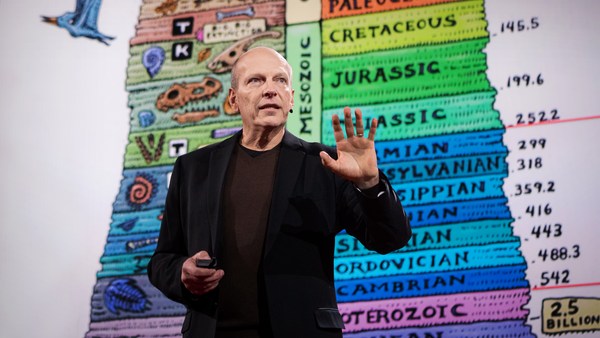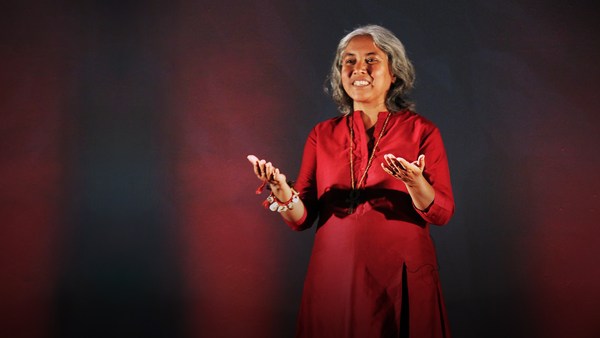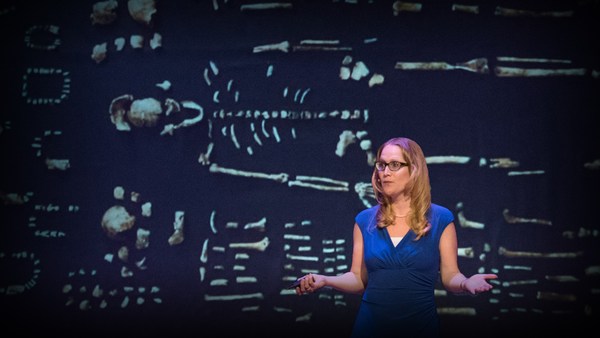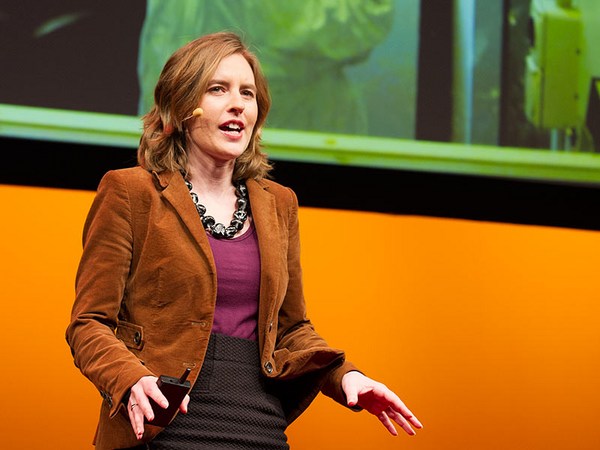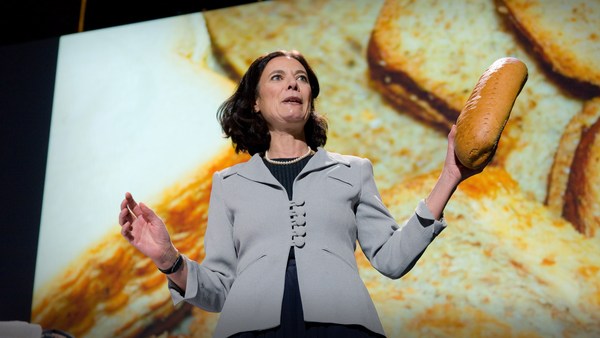I want you to think about the image that you see when I say one word: migrant. You may have pictured a crowded boat in rough waters, people clinging to the top of a freight train or crossing a desert wearing worn-out shoes. This is what we see in the news cycle, 24 hours, day after day, story after story. People who are desperate, fleeing wars, fleeing climate change, fleeing poverty. But in reality, most people move for more common reasons: to get a good education, to find a job, to find family members or to fall in love. And this is nothing new. Archaeologists like me have been studying migration and finding that people for hundreds and even thousands of years have been moving around the globe. From Europe's earliest farmers to Vikings to pirates, Roman gladiators and even Neanderthal cavemen, and people like you and me. Mobility is one of the things that makes us human. People move.
And we know this because of something that you brought with you here tonight. You carry it with you to many places: to work, to the gym, to bed, and even in the shower. It’s not your cell phone, and it's not in your purse or your pockets. It's you. It's your body and your bones, all 206 of them. I brought mine and in case for some reason you didn’t bring yours along, we do have an extra one here because your bones will tell the story of your life, even a single tooth. And we know that teeth tell us many things. For your dentist, for example. He or she can see if you floss or if, like me, you really like candy, and you might end up with some cavities. And if my dentist is here tonight, yes, I will see you Monday. And I've been very good. But your teeth also tell you something about migration. If you take your tongue and run it along your incisors, these front teeth, the back of those will be flat if you have European or African ancestry, if you feel a sort of scoop or shovel shape, your ancestors may have been Native American or migrated from Asia. If we go inside the tooth to the pulp cavity, we may be able to extract the DNA and see if your ancestors came from Egypt or England or both.
But we're not interested as much in your family's migration history as yours. And that's where we go to the tooth enamel, what it's made out of, to try and find out if a person moved and even when they moved. And it's based on one simple idea: that you are what you eat. All the minerals and the elements in the food, like calcium, oxygen, which is the O in H2O, sodium and salt, can tell us something about your diet. So we know if you like cornbread or white bread, if you prefer pork, chicken or if you really like seafood. There are other elements that tell us where that food came from, and that includes sulfur, strontium, oxygen and even lead, which, of course, you don't want very much of. But these tell us where the food comes from and that can tell us where you were when you were eating it. And that is what archaeologists use to identify ancient migration.
If we look inside the tooth enamel, we can see, for example, in your first molar -- this is the one that was forming along with your baby teeth, but it's the only one you still have -- and that tells us where you were living as an infant. If we look at the wisdom tooth, which is the last tooth to form, that enamel would have been mineralizing just before you hit your teenage years. So we know where you're living then. If we look at your bones -- and in that pause, you just formed some new bone cells -- that’s telling us what you’re eating and what you’re doing in just about the past decade of life, so we can really track where people moved. And we've looked at this for hundreds and thousands of individuals to identify migration in the past. So I'd like to introduce you to some ancient migrants.
If we go back in time 1600 years, we can go to the city of Copán, where the Maya people lived in what's now Honduras. If we came around the year 400 AD, we might have walked into broad plazas under a really hot tropical sun that was shining onto bright red-painted buildings that had altars and carved statues in front of them. If we'd come on the right day, we might have seen the inauguration of ruler K'inich Yax K'uk' Mo', roughly translated, that means Sun-Faced First Macaw. The Maya rulers had really great names: Bird Jaguar, Dark Sun, Lady Great Skull. But what was really neat about Yax K'uk' Mo' is that he established a dynasty that lasted for more than 400 years. And every depiction we have of him, as you see here, shows him in foreign clothing. This is what people wore in central Mexico, which was not in the Maya region and actually hundreds of miles away. So for a long time, archaeologists thought that this was a foreign king.
But his teeth told a different story. By sampling his first molar, his wisdom tooth and bone, we found that he, in fact, probably came from somewhere in the Maya region. So he was a migrant, but he may have lived in multiple places before coming to live at Copán, even though he dressed like he was a foreigner, someone from Mexico. And I always think about when the Chicago Cubs were in the World Series and people went out and bought Cubs gear, even though maybe they'd never been to Chicago. It's a good look.
But let me take you to another Maya city. And this is where I work, called Xunantunich. In 2016, archaeologists found the largest tomb ever discovered in the country, in Belize -- that's where Xunantunich is. And inside that tomb, there were the remains of a ruler, but also jade, the kind of plates and the kind of vessels that you might see in a museum, and jaguar bones, which symbolize possibly royal power. This person may have actually even been wearing a jaguar pelt cape. But Xunantunich was a fairly small city. So there was a possibility that this was a foreign ruler. But in fact, looking at the DNA and looking at the tooth enamel, this was no foreign king. She was a Maya queen or some other royalty who was probably local. We actually don't usually find foreign kings and queens. But I told you the story was about migrants. And it is, because, in fact, it was the commoners who moved. Up to 25 percent of the population of every village and every city consisted of migrants -- men, women and children who'd moved, sometimes from multiple places, to live in the same household. Migration seemed to be common among the Maya and many ancient civilizations. But we can move forward in time to the year 1493, when Christopher Columbus set off on his second voyage to establish a trading outpost. He left with 17 ships and 1,200 men, nobility, clergy, sailors and craftsmen to establish what we now know as La Isabela, named after Queen Isabella, in the northern part of the Dominican Republic, or La Española, as they called it then. Things were not good: food was scarce, disease was rampant and Columbus may not have been the best manager, so mortality rates were high. And by the 1980s and 90s, when archaeologists began to excavate the settlement and then the cemetery, they started to wonder: Did the ships’ rosters include everyone who is buried here? Who actually lived at La Isabela? My job came a bit later as a graduate student when I was tasked with going around the island to try and collect samples that could serve as proxies for human teeth. What would the enamel look like of the people who were living at La Isabela? Someone else got to go to Spain, but I rented a car, drove around, went into the mountains, drove toward the river valleys. And of course, I went to a beach or two. And everything was going really well until the last day when I came to what was supposed to be a bridge and saw a river and a herd of cows. So it was getting dark. I was by myself. I was low on gas. And after I saw some cowboys on the other side of the river kind of waving their hands, I just rolled down the window and gunned it. And I made it across and I had the samples, which was a good thing because there were some surprises. We did find soldiers and people from Spain, probably Andalusia, where Columbus sailed from, and maybe other parts of the Mediterranean. But we also found an indigenous Taíno woman, a local one, and other women who came from Europe, and one person who, if we can get some DNA to see if this is actually true, may have been from Africa. None of these people were on the ships' rosters. Teeth can tell us things that the history books leave out.
Our final story brings us back closer to Mississippi to an abandoned cemetery just west of Jackson, where we can learn about the lives of the settlers who lived here in the early 1800s. Now, some of them came with wealth. They could erect tombstones and write their life histories on their graves. If they were married, whether they had children, where they came from and sometimes even how they died, as cholera and yellow fever epidemics swept through the region. Richard lived until age 56. He died in 1849. Charles had a shorter life. In 1855, he'd survived only to age 29. But these men were planters, and we know that they brought enslaved people with them. Where were they buried? And what about the poor farmers and the sharecroppers? There were more than 350 graves in the cemetery. And so we decided to do our best to solve these historic forensic cases and reconstruct the lives of the people who lived there. And one of these people, one of the migrants, was a man buried in grave 3. He was of African descent. He lived into the middle, maybe even old age, by the time he died in the early 1900s. He was probably born into slavery. And so we wonder, was he brought to Mississippi? Was he taken from his family like so many enslaved children were? Or did he come after the Civil War to make a new life for himself, or find family? He and the men with similar life histories, migrants who are buried in grave 18 and grave 219, they made a good enough living that their families were able to give them nice burials, maybe even expensive ones. So even if we can't say their names, we can at least tell something of their stories.
And migration is part of my story, too. My grandparents came from Germany. My grandpa in 1923, to join his uncle. And my grandma a few years later. We just found their travel documents and a picture of my grandma on a lounge chair on one of the big ships that sailed across the Atlantic. We actually don't know exactly why they came, but I imagine it's for the same reason that people come today to the United States: because they had a hunger and a hope, if not to make life better for themselves, to do it for their kids. They met in Chicago, got married and had two boys, one of those was my dad. I’m the third generation of my family to be here, and I’m also a migrant. I've come less than 10 years ago from the Midwest to live in Mississippi. So whether your family has an ancient migration story or whether you look in the mirror and see yours, remember that every time you smile and show your teeth, you're sharing that.
Thank you.
